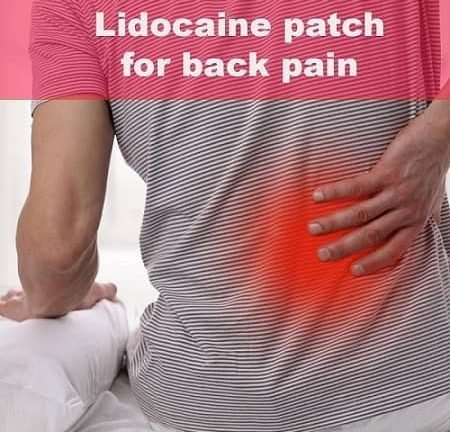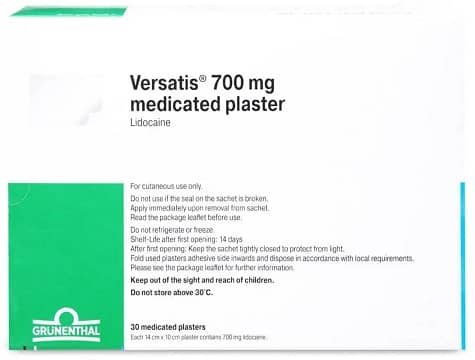If you’ve ever experienced the relentless discomfort of back pain, you know all too well the limitations it can place on your daily life. Whether it’s caused by muscle strains, chronic conditions, or even lingering injuries, finding effective relief can be a challenging pursuit. Amidst a sea of treatments and remedies, one soothing solution stands out: the Lidocaine patch for back pain.
What is a lidocaine patch?
Lidocaine patch (brand name: Versatis medicated plaster) is a prescription-only medication, which has limited licensed use in the UK. Lidocaine patch offers a different approach to pain management as compared to standard analgesic drugs such as paracetamol, codeine and alternative drugs.
As the name suggests, lidocaine patch is a medicated plaster which contains a local anaesthetic – lidocaine 5%. Lidocaine patch is known by its branded name – Versatis 700 mg medicated plaster. The patch dimensions are 10 cm x 14 cm. Each patch contains 700 mg of lidocaine, which is equivalent to 5% of lidocaine in each plaster.
Lidocaine patch is a prescription-only medication which means a doctor or another qualified prescriber needs to issue a prescription (NHS or private prescription) for a patient to get the supply of this medicine.
What is lidocaine?
Lidocaine belongs to a group of drugs called local anaesthetics. Local anaesthetics have a different mechanism of action as compared to ‘standard’ pain relievers which are available in the form of tablets or over the counter patches. Lidocaine blocks nerves locally and therefore stops sending pain signals to the brain.
Lidocaine is available as an active ingredient in different over the counter medicines, for example:
- Anbesol liquid (cetylpyridinium chloride, chlorocresol, lidocaine hydrochloride): used as a pain reliever due to recurrent mouth ulcers and denture irritation
- Anbesol Adult Strength Gel (cetylpyridinium chloride, chlorocresol, lidocaine hydrochloride): the same licensed use as the above product.
- EMLA cream (lidocaine, prilocaine): used as a local anaesthetic cream to numb the skin before superficial skin procedures or injections
How is the lidocaine patch used?
Each Versatis patch is applied to the skin and can be worn for up to 12 hours. Patients need to have 12 hours break before applying a new patch.
Lidocaine patch for back pain: the UK-licensed use
Versatis medicated plaster is licensed in the UK for symptomatic relief of neuropathic pain in connection with previous herpes zoster infection (shingles) in adults. The medical name of this condition is post-herpetic neuralgia (PHN).
PHN is a nerve pain which usually affects the area that was affected by shingles. Patients who experience PHN are unlikely to benefit from ‘standard’ painkillers such as paracetamol or ibuprofen. A combination of paracetamol with or without codeine (co-codamol) is recommended as one of the treatment options according to the national guide (NICE, 2017) on PHN management. Other options for the treatment of PHN include drugs which are used for the management of neuropathic pain, such as amitriptyline, duloxetine, gabapentin, or pregabalin (ibid).
Lidocaine plasters are recommended as optional therapy in the elderly population if there is concern about the potential side effects of oral medicines or as additional treatment if severe PHN pain is experienced.
Lidocaine patches are not recommended in the management of neuropathic pain.
This is a limited licensed use, however, like with many other drugs, a doctor can prescribe medicines outside of its licensed use.
The high price for Versatis medicated plasters reduces prescribing of this drug.
Can you use a lidocaine patch for back pain?
Lidocaine patches have a specific use as described in the above paragraphs. It is possible to use a lidocaine patch for back pain, not necessarily caused by previous shingle infection but for example due to neuropathic pain. This, however, would be the unlicensed use of lidocaine patches. A doctor can prescribe medicines outside of their license based on an assessment of the individual patient and when it is necessary to meet the specific needs of the patient’ (GMC, n.d.)
Is a lidocaine patch effective in the management of back pain?
A small study looked at the effectiveness of lidocaine patches in the management of pain caused by three different conditions – post-herpetic neuralgia (PHN), painful diabetic neuropathy (DN), and low-back pain (LBP). It was concluded that lidocaine 5% patch effectively reduces pain in patients with moderate to severe chronic pain resulting from all three conditions mentioned previously (Argoff et al., 2004). This study, however, does not meet standards in terms of quality to be included in the NICE guideline (a guide which advices healthcare professionals in the UK on the treatment of conditions) as evidence supporting their preferred use.
Systemic reviews (a study which compares all available evidence), including the Cochrane review (Derry et al., 2014), concluded that there is limited evidence from good clinical studies to support the use of lidocaine patches.
Despite recommendations against the use of lidocaine patches for neuropathic pain other than those associated with PHB, lidocaine is effective in the management of this type of pain. When used in the form of topical patches or creams, it can help provide targeted relief for neuropathic pain, which is caused by damage or dysfunction of the nervous system.
Lidocaine patches work by numbing the area where they are applied, which can help alleviate the burning, tingling, and shooting pain often associated with neuropathy.
One of the main advantages of using Lidocaine patches is that they have a lower risk of systemic side effects compared to oral medications. Since the medication is applied directly to the affected area, it does not enter the bloodstream in significant amounts, reducing the likelihood of systemic adverse effects.
How much lidocaine patch cost?
The cost of lidocaine patches applies only to patients who get a private prescription for this medication. When a drug is prescribed on a private prescription, a customer needs to cover the cost of the drug supplied plus an additional dispensing fee, which varies between pharmacies, but usually adds to 10%-20% to the cost of medication supplied.
The cost of lidocaine patches (Versatis medicated plasters) is £72.40 for a box of 30 patches (price source AAH Pharmaceuticals, August 23′). With an additional dispensing fee patients can be expected to pay around £90 for a box of 30 lidocaine patches.
Patients who get medicines prescribed on the NHS prescription pay a standard prescription fee or get medication for free, when exempt from paying.
Alternative options to lidocaine patch for back pain
Staying in the area of back pain management with patches only, over the counter products listed below represent a few options for back pain management
- Nurofen patches – a medicated plaster containing 200mg of ibuprofen (NSAID)
- Voltarol Medicated Plasters – a medicated plaster containing 140mg of diclofenac (NSAID)
- Cura Heat Back & Shoulder Pain
Cura-Heat patches are self-heating patches designed to provide temporary relief from muscular aches, joint stiffness, and other minor pains.
The key components of a Cura-Heat patch include iron powder, activated carbon and water.
When exposed to air, these ingredients undergo an exothermic reaction, generating heat. The iron powder in the patch reacts with oxygen, producing heat as a byproduct. This heat is then released gradually over several hours, allowing the patch to provide continuous warmth to the affected area.
Heat therapy can be beneficial for relieving back pain in certain situations. Applying heat to the affected area can help relax muscles, improve blood flow, and reduce stiffness, which can all contribute to pain relief.
No products found.
4. Deep Heat Pain Relief Heat Patches
No products found.
Deep Heat patches have three different active ingredients, methyl salicilate:12.80%w/w, menthol:5.91%w/w, and eucalyptus Oil 1.97% w/w. The principle of pain management with Deep Heat patches is the same, use of heat to relieve pain.
5. Salonpas Pain Relief Patch – a medicated patch containing Methyl Salicylate 105mg & Levomenthol 31.5mg
No products found.
Over the counter paracetamol, ibuprofen and over the counter codeine containing medicines should also be considered in the management of back pain.
References
Argoff CE, Galer BS, Jensen MP, Oleka N, Gammaitoni AR. Effectiveness of the lidocaine patch 5% on pain qualities in three chronic pain states: assessment with the Neuropathic Pain Scale. Curr Med Res Opin. 2004;20 Suppl 2:S21-8. doi: 10.1185/030079904X12960. PMID: 15563743. Available at: https://doi.org/10.1185/030079904×12960 Accessed on 07/08/2023
Derry S, Wiffen PJ, Moore RA, Quinlan J. Topical lidocaine for neuropathic pain in adults. Cochrane Database Syst Rev. 2014;2014(7):CD010958. Published 2014 Jul 24. doi:10.1002/14651858.CD010958.pub2 Available at: https://dx.doi.org/10.1002%2F14651858.CD010958.pub2 Accessed on 07/08/2023
GMS (n.d.) Prescribing unlicensed medicines. Available at: https://www.gmc-uk.org/ethical-guidance/ethical-guidance-for-doctors/prescribing-and-managing-medicines-and-devices/prescribing-unlicensed-medicines Accessed on 07/08/2023
NICE (2017). Post-herpetic neuralgia: management. Available at: https://cks.nice.org.uk/topics/post-herpetic-neuralgia/management/management/ Accessed on 07/08/2023





